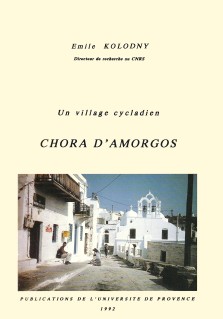|
Chóra
d'Amorgós, un village cycladien / Emile Kolodny. -
Aix-en-Provence : Publications de l'université de
Provence, 1992. -
269 p.-[1] dépl. :
ill. ; 25 cm.
ISBN 2-85399-303-5
|
NOTE
DE L'ÉDITEUR : L'île
d'Amorgós (126 km2
et 1 636 habitants en 1991) est une île grecque,
située
dans la partie orientale des Cyclades, en mer Egée. Depuis
l'époque médiévale jusqu'aux
années
soixante-dix, elle est demeurée une lointaine
“ île de terriens ”,
vivant de petite
polyculture et de l'émigration. La découverte par
le
grand public de son monastère byzantin, flanqué
sur
l'abrupt de la côte méridionale
— notamment
après le tournage du film Le Grand Bleu
(1987) — remet en question les avantages
tirés d'une
fréquentation touristique limitée,
adaptée
à des structures d'accueil sommaire, et
gérées
pour l'instant encore par les autochtones.
Cet ouvrage
consacré principalement à l'étude du
chef-lieu de
l'île, le pittoresque village perché de
Chóra, est
le résultat d'enquêtes amorcées en
1966, et reprise
régulièrement entre 1986 et 1991. L'auteur pose
la
question du devenir de cette île mineure en
Méditerranée, l'accession à la
modernité
allant de pair avec la fragilité des nouvelles ressources.
La
documentation de première main concernant l'habitat, la
population d'un microcosme et ses multiples activités, est
assortie d'une description vivante, montrant l'existence au quotidien
des gens d'Amorgós.
| ❙ |
Emile
Kolodny est né à Paris en 1932.
Géographe,
directeur de recherche honoraire au CNRS (1964-1997),
rattaché
à la Maison Méditerranéenne des
Sciences de
l'Homme à Aix-en-Provence. Spécialiste en
géographie humaine des îles et pays de la
Méditerranée, il a travaillé surtout
sur les
îles de la Grèce (Crète, îles
de
l'Egée et de la mer Ionienne), Chypre, la Corse, la
Sardaigne et
les îles Dalmates. |
|
|
STÉPHANE
AUBRIET :
Emile Kolodny's book is so complete that it does not only introduce
Chora, the county-town of Amorgos island, the eastmost among the
Cyclades. In fact it deals with the island at large, as the titles of
the three parts suggest :
- Amorgos,
a remote Cyclade,
- Flimsy
demography of a microcosm,
- An
island of people in search of new resources.
This is the framework for this
200 pages-work, without mentioning some fifty pages in the
annex (including a glossary, bibliography and statistical tables).
Though containing
a mine of information on the daily
life of the islanders as well as their history and
their demographic changes, this book remains pleasant to read
and this for several reasons. Evocative titles, a
lively style, a call to original historical sources
(such as the stories of the travellers in
past centuries), precise details, contribute in making this
book interesting and alive. The author tells us about the
destiny of some of the islands's characters (their work and fate) and
also describes scenes important to Chora's life, such as the
arrival of the ferryboat.
One of the great
attributes of this book is that it studies the contemporary phenomena
in a dynamic historical perspective. Indeed,
the author has personal notes covering the 1966-1991
period, during which society in Chora has evolved
faster than it has in the last centuries.
The subjects of interest
are numerous. These include the history of Greece
seen from a narrow angle, the good and bad
fortunes of the Cyclades along the
centuries, and the infrastructures and
public equipment of a Greek island in the
present times. The book discusses how a small island of
126 km2
and 16,000 inhabitants copes with its transportation,
water provision and education problems. The parallel evolution of Chora
(the old village located on the hills) and
of its port Katapola and the organization and exploitation of
lands and meadows on the main island
and neighbouring ones, attached to Amorgos,
are also discussed.
This deep study of a
tiny village eventually gives a complex but realistic view
of the island's community. In brief, a very interesting
book for researchers as well as
for the lay-man. A tremendously well documented
publication, in which the oral sources compensate the
small amount of written ones.
☐ Insula, 2,
December 1993
|
| COMPLÉMENT
BIBLIOGRAPHIQUE |
→ Roger Livet,
« Un village cycladien : Chora d'Amorgos.
Kolodjy, E.,
(1992) » — note de lecture, Méditerranée,
1992 | 76 | pp. 83-84 [en
ligne]
→ Stéphane
Yerasimos, « Kolodny (Emile), Un village cycladien
Chora
d'Amorgos, 1992 » — note de
lecture, Cahiers
d'études sur la Méditerranée Orientale
et le monde Turco-Iranien, 1994 | 17 |
p. 339 [en
ligne]
|
- Emile
Kolodny, « La
géographie urbaine de la Corse »,
Paris : Sedes, 1962
- Emile
Kolodny, « La
population des îles de la Grèce : essai
de géographie insulaire en
Méditerranée orientale »
(3 vol.), Aix-en-Provence : Edisud, 1964
- Emile
Kolodny, « Samothrace-sur-Neckar :
des migrants grecs dans l'agglomération de
Stuttgart », Aix-en-Provence : Institut de
recherches méditerranéennes, 1982
- Emile
Kolodny, « Îles
et populations en Méditerranée orientale »,
Istanbul : Isis (Analecta Isisiana, 79), 2004
|
|
|
| mise-à-jour : 7 octobre 2022 |
 |
|
|
|